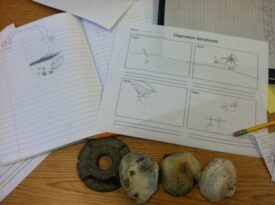To explain ocean acidification to second graders, here’s a start: Think of carbon dioxide as an evil ninja.
He’s buried in the ground in the form of coal, oil or some other fossil fuel. Someone digs him up and lights him on fire, sending him up into the atmosphere in a plume of smoke, or perhaps a polluting helicopter. The stealthy ninja parachutes out and lands in the ocean, where he begins to turn the ocean more acidic.
The ninja also runs into a happy clam, whose shell is made of calcium and carbonate. But the evil ninja breaks the molecule apart, kidnaps the carbonate and locks it away where no one can get to it. With that fundamental bond broken, the shell dissolves, the clam inside dies, and sea life as we know it is under attack.
That, at least, is the way students from the Suquamish Tribe Middle School see the situation unfolding in our oceans, as they brainstorm ideas for an animated video that will help younger kids understand the mechanics of ocean acidification. It’s a problem that people like Paul Williams, the shellfish management policy advisor for the tribe, sees as a grave threat to their culture. As he explained to a room of 11- to 14-year-old students on a recent summer day:
The goal today is to make videos to explain what’s going on out on the water because this is your future. If any of you want to be fishermen or fisherwomen, it’s really up to you guys. This is something that’s happening right now and it’s getting worse. If we want to have any alternative to McDonald’s, we’re going to have to work on this. And I have to apologize to you because my generation couldn’t do it. It’s a shame to have to tell you guys that this is your problem…but it’s the truth and I think you guys are old enough to be told the truth.
Inside the science classroom, Devin, Dylan and Hailey Crow and Steven Holt make lists of the materials they’ll need for the animation: ninjas, clams, a helicopter, parachute, sand, shovels, smoke bombs (maybe), and a dog bowl that could stand in for the ocean. With the help of Charlie Daugherty, a volunteer from the Seattle Experimental Animation Team, they plan to transform the idea into a stop motion video on ocean acidification for younger tribal members. The kids are most animated when discussing the prospect of lighting things on fire (an idea nixed by their teacher) or debating whether they could act this out themselves in ninja costumes (an idea nixed by the most practical of the bunch), but the larger lesson isn’t entirely lost.
The Suquamish Tribe’s ancestral home is on Agate Pass, the strait that separates Washington’s Bainbridge Island from the Kitsap Peninsula. Without a major salmon river in their territory, they relied on shellfish and traveled far and wide to find salmon, a tradition that continues today. Last year, the tribe commercially harvested more than 415,000 pounds of giant geoduck clams, using those profits to fund social service programs and provide disbursements to elders. Individuals or families harvested 308,000 pounds of Dungeness crab; 33,000 pounds of horse, manila, and littleneck clams; 14,000 pounds of shrimp and about 410,000 pounds of salmon.
Each of those harvests could be threatened by ocean acidification, directly or indirectly. As seawater absorbs increasing levels of carbon dioxide released by burning fossil fuels, it becomes more acidic. In the process, carbonate minerals—one of the basic building blocks that everything from plankton to crab to geoducks need to build shells and skeletons—become less available. As even more carbon dioxide is added to seawater, the shells of some species—such as tiny sea snails that some Alaskan salmon feast on—begin to dissolve.
Right now, oysters and mollusks appear to be the most vulnerable. But researchers are running experiments right now on other ecologically or economically important Northwest creatures to see how they will react with more acidic seas. The Suquamish tribe is helping fund some of the work to predict how Dungeness crab larvae will be affected, through a multi-pronged grant that the tribe is using to raise knowledge and awareness of ocean acidification.
Charissa Sigo, 18, had never heard of ocean acidification until last year, even though there’s a long line of fisherpeople in her family, including her aunt, uncle and grandfather. They keep some of the crab, salmon and shrimp for their family, sell some on the reservation and donate some to elders and for tribal events.
When a representative from the Seattle Aquarium visited her school, Sigo and four other students from the Suquamish Early College High School volunteered to make a video on ocean acidification, visiting research laboratories and talking to elders about changes they’ve seen on the water. They were chosen to present their findings at a student summit on ocean issues in Washington DC and screen their video at the Smithsonian earlier this year. The research opened Sigo’s eyes:
My people come from water so we basically live off the water. We go canoeing and a lot of our food comes from the water, the salmon and the crab and the shellfish. I didn’t know our resources were dying, so I figured I ought to get involved….If sea life is suffering, our people are too, or will be.
Before getting involved with the aquarium and Coastal America, a partnership of federal agencies and private alliances that work on ocean conservation and supported the students’ work, Sigo was planning to get a degree in psychology and become a mental health counselor. Now, she’s thinking about switching to marine biology so she can help educate tribes about the progress—or lack thereof—that’s being made on the issue.
Her hope is that people will stop burning so much fossil fuel, start leaving their cars at home, take public transportation, walk, bike, run. And that among the general public the awareness of ocean acidification and what’s at stake becomes much higher than it is now, Sigo said.
Interviewing tribal elders I pretty much heard people have been saying my whole life, that when they were younger everything was a lot easier and they had a lot of fish and now there’s hardly any. … My fear is that everything is going to die off and our culture is going to die off and we’re going to have to adapt and change to something else.
In our next post, we’ll look at some of the policy changes that could keep that scenario from coming to pass.











Matthew Huelsenbeck
Fantastic idea! I am a marine scientist at the marine conservation organization, Oceana, and I work on communicating the issue of ocean acidification and advocating for ways to stop it. It just may be that these middle schoolers can help teach us how to communicate this complex issue so that politicians and everyone can understand. Let me know if I can help, and please send the videos along once they are completed so I can share them!